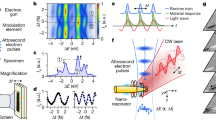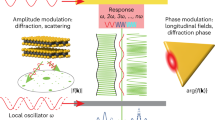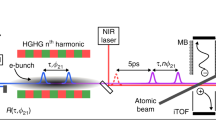Abstract
Coherent manipulation of quantum systems with light is expected to be a cornerstone of future information and communication technology, including quantum computation and cryptography1. The transfer of an optical phase onto a quantum wavefunction is a defining aspect of coherent interactions and forms the basis of quantum state preparation, synchronization and metrology. Light-phase-modulated electron states near atoms and molecules are essential for the techniques of attosecond science, including the generation of extreme-ultraviolet pulses and orbital tomography2,3. In contrast, the quantum-coherent phase-modulation of energetic free-electron beams has not been demonstrated, although it promises direct access to ultrafast imaging and spectroscopy with tailored electron pulses on the attosecond scale. Here we demonstrate the coherent quantum state manipulation of free-electron populations in an electron microscope beam. We employ the interaction of ultrashort electron pulses with optical near-fields4,5,6,7,8,9 to induce Rabi oscillations in the populations of electron momentum states, observed as a function of the optical driving field. Excellent agreement with the scaling of an equal-Rabi multilevel quantum ladder is obtained10, representing the observation of a light-driven ‘quantum walk’5 coherently reshaping electron density in momentum space11. We note that, after the interaction, the optically generated superposition of momentum states evolves into a train of attosecond electron pulses. Our results reveal the potential of quantum control for the precision structuring of electron densities, with possible applications ranging from ultrafast electron spectroscopy and microscopy to accelerator science and free-electron lasers.
This is a preview of subscription content, access via your institution
Access options
Subscribe to this journal
Receive 51 print issues and online access
$199.00 per year
only $3.90 per issue
Buy this article
- Purchase on Springer Link
- Instant access to full article PDF
Prices may be subject to local taxes which are calculated during checkout



Similar content being viewed by others
References
Bouwmeester, D., Ekert, A. & Zeilinger, A. The Physics of Quantum Information (Springer, 2000)
Krausz, F. & Ivanov, M. Attosecond physics. Rev. Mod. Phys. 81, 163–234 (2009)
Itatani, J. et al. Tomographic imaging of molecular orbitals. Nature 432, 867–871 (2004)
Barwick, B., Flannigan, D. J. & Zewail, A. H. Photon-induced near-field electron microscopy. Nature 462, 902–906 (2009)
García de Abajo, F. J., Asenjo-Garcia, A. & Kociak, M. Multiphoton absorption and emission by interaction of swift electrons with evanescent light fields. Nano Lett. 10, 1859–1863 (2010)
Park, S. T., Lin, M. & Zewail, A. H. Photon-induced near-field electron microscopy (PINEM): theoretical and experimental. New J. Phys. 12, 123028 (2010)
Kirchner, F. O., Gliserin, A., Krausz, F. & Baum, P. Laser streaking of free electrons at 25 keV. Nature Photon. 8, 52–57 (2013)
Peralta, E. A. et al. Demonstration of electron acceleration in a laser-driven dielectric microstructure. Nature 503, 91–94 (2013)
Breuer, J. & Hommelhoff, P. Laser-based acceleration of nonrelativistic electrons at a dielectric structure. Phys. Rev. Lett. 111, 134803 (2013)
Shore, B. W. & Eberly, J. H. Analytic approximations in multi-level excitation theory. Opt. Commun. 24, 83–88 (1978)
Bouwmeester, D., Marzoli, I., Karman, G., Schleich, W. & Woerdman, J. Optical Galton board. Phys. Rev. A 61, 013410 (1999)
García de Abajo, F. J. Optical excitations in electron microscopy. Rev. Mod. Phys. 82, 209–275 (2010)
Hemsing, E., Stupakov, G., Xiang, D. & Zholents, A. Beam by design: laser manipulation of electrons in modern accelerators. Rev. Mod. Phys. 86, 897–941 (2014)
Krüger, M., Schenk, M. & Hommelhoff, P. Attosecond control of electrons emitted from a nanoscale metal tip. Nature 475, 78–81 (2011)
Herink, G., Solli, D. R., Gulde, M. & Ropers, C. Field-driven photoemission from nanostructures quenches the quiver motion. Nature 483, 190–193 (2012)
Wimmer, L. et al. Terahertz control of nanotip photoemission. Nature Phys. 10, 432–436 (2014)
Schiffrin, A. et al. Optical-field-induced current in dielectrics. Nature 493, 70–74 (2012)
Piglosiewicz, B. et al. Carrier-envelope phase effects on the strong-field photoemission of electrons from metallic nanostructures. Nature Photon. 8, 37–42 (2013)
Stockman, M. I., Kling, M. F., Kleineberg, U. & Krausz, F. Attosecond nanoplasmonic-field microscope. Nature Photon. 1, 539–544 (2007)
Kapitza, P. L. & Dirac, P. M. The reflection of electrons from standing light waves. Math. Proc. Camb. Phil. Soc. 29, 297–300 (1933)
Freimund, D. L., Aflatooni, K. & Batelaan, H. Observation of the Kapitza-Dirac effect. Nature 413, 142–143 (2001)
Smith, S. & Purcell, E. Visible light from localized surface charges moving across a grating. Phys. Rev. 92, 1069 (1953)
Mizuno, K., Pae, J., Nozokido, T. & Furuya, K. Experimental evidence of the inverse Smith-Purcell effect. Nature 328, 45–47 (1987)
Flannigan, D. J., Barwick, B. & Zewail, A. H. Biological imaging with 4D ultrafast electron microscopy. Proc. Natl Acad. Sci. USA 107, 9933–9937 (2010)
Yurtsever, A., van der Veen, R. M. & Zewail, A. H. Subparticle ultrafast spectrum imaging in 4D electron microscopy. Science 335, 59–64 (2012)
Ropers, C., Solli, D. R., Schulz, C. P., Lienau, C. & Elsaesser, T. Localized multiphoton emission of femtosecond electron pulses from metal nanotips. Phys. Rev. Lett. 98, 043907 (2007)
Hommelhoff, P., Kealhofer, C. & Kasevich, M. A. Ultrafast electron pulses from a tungsten tip triggered by low-power femtosecond laser pulses. Phys. Rev. Lett. 97, 247402 (2006)
Gulde, M. et al. Ultrafast low-energy electron diffraction in transmission resolves polymer/graphene superstructure dynamics. Science 345, 200–204 (2014)
Moharam, M. G. & Young, L. Criterion for Bragg and Raman-Nath diffraction regimes. Appl. Opt. 17, 1757–1759 (1978)
Baum, P. & Zewail, A. H. Attosecond electron pulses for 4D diffraction and microscopy. Proc. Natl Acad. Sci. USA 104, 18409–18414 (2007)
Case, W. B., Tomandl, M., Deachapunya, S. & Arndt, M. Realization of optical carpets in the Talbot and Talbot-Lau configurations. Opt. Express 17, 20966–20974 (2009)
Harris, S. E. & Sokolov, A. V. Subfemtosecond pulse generation by molecular modulation. Phys. Rev. Lett. 81, 2894–2897 (1998)
Mandel, L. & Wolf, E. Optical Coherence and Quantum Optics (Cambridge Univ. Press, 1995)
Park, S. T., Kwon, O.-H. & Zewail, A. H. Chirped imaging pulses in four-dimensional electron microscopy: femtosecond pulsed hole burning. New J. Phys. 14, 053046 (2012)
Plemmons, D., Park, S. T., Zewail, A. H. & Flannigan, D. J. Characterization of fast photoelectron packets in weak and strong laser fields in ultrafast electron microscopy. Ultramicroscopy 146, 97–102 (2014)
Egerton, R. F. Electron energy-loss spectroscopy in the TEM. Rep. Prog. Phys. 72, 016502 (2009)
Schmidt, S. et al. Adiabatic nanofocusing on ultrasmooth single-crystalline gold tapers creates a 10-nm-sized light source with few-cycle time resolution. ACS Nano 6, 6040–6048 (2012)
Ibe, J. et al. On the electrochemical etching of tips for scanning tunneling microscopy. J. Vac. Sci. Technol. A 8, 3570–3575 (1990)
Asenjo-Garcia, A. & García de Abajo, F. J. Plasmon electron energy-gain spectroscopy. New J. Phys. 15, 103021 (2013)
Park, S. T. & Zewail, A. H. Relativistic effects in photon-induced near field electron microscopy. J. Phys. Chem. A 116, 11128–11133 (2012)
Schäfer, J., Lee, S.-C. & Kienle, A. Calculation of the near fields for the scattering of electromagnetic waves by multiple infinite cylinders at perpendicular incidence. J. Quant. Spectrosc. Radiat. Transf. 113, 2113–2123 (2012)
Piazza, L. et al. Simultaneous observation of the quantization and the interference pattern of a plasmonic near-field. Nature Comm. 6, 6407 (2015)
Acknowledgements
We thank M. Sivis and B. Schröder for help with sample preparation. We also thank our colleagues within the Göttingen UTEM initiative (C. Jooß, M. Münzenberg, K. Samwer, M. Seibt, C.A. Volkert). This work was supported by the Deutsche Forschungsgemeinschaft (DFG-SFB 1073/project A05), the VolkswagenStiftung, and the Lower Saxony Ministry of Science and Culture. We thank JEOL Ltd and JEOL Germany for their continuing support during the development of the Göttingen Ultrafast Transmission Electron Microscope.
Author information
Authors and Affiliations
Contributions
The experiments were carried out by A.F., with contributions from J.S. and S.S.; S.S. and C.R. conceived and directed the study; S.V.Y. developed the analytical description and K.E.E. carried out the numerical simulations, each with contributions from A.F., S.S. and C.R.; the manuscript was written by A.F., K.E.E., S.S. and C.R., after discussions with and input from all authors.
Corresponding authors
Ethics declarations
Competing interests
The authors declare no competing financial interests.
Extended data figures and tables
Extended Data Figure 1 Experimental setup.
Pulses from an amplified femtosecond (fs) laser system, at bottom left, are split into two optical beams. One of them is frequency-doubled in a β-barium borate (BBO) crystal and, after separation from the fundamental beam, focused (lens with numerical aperture 0.015, 50 cm focal length) onto the tungsten needle emitter (W tip) for the generation of electron probe pulses. The second beam (pump beam) is temporally stretched, attenuated and focused (lens with numerical aperture 0.014, 20 cm focal length) onto the sample within the TEM (angle of incidence, 55°). Relative timing between the electron probe and laser pump pulse is controlled by an optical delay stage. Optically-induced changes of the population of electron momentum states are recorded with an electron energy spectrometer. See Methods for details.
Extended Data Figure 2 Spatial characterization of near-field scattering.
a, Raster scan of the optically-induced electron energy gain and loss probability, characterized by the spectral cutoff (top panel) and the sideband populations of the zero loss peak (middle) and the second photon order (bottom). The field-dependent electron energy spectra shown in Fig. 2 of the main text were recorded at an x position indicated by the black line at the tip surface. A slow sample drift results in a scanning artefact in the y direction (jagged edge of the tip). For the results reported in the main text, a drift correction in the y direction was applied (see Methods section ‘Data analysis and drift correction’). b, TEM image of gold tip. Red rectangle, scanning area displayed in a. c, Electron energy-loss spectra recorded along x = 0 with varying distance from the tip surface.
Extended Data Figure 3 Pulse characterization by electron–photon cross-correlation.
a, Differential electron energy-loss spectra as function of time delay (zero loss peak of width 1.3 eV subtracted; the colour scale shows the relative change of spectral density). b, Relative total scattering amplitude as function of time delay (inset, relative shift of photon sidebands with respect to zero loss peak). c, Energy- and time-resolved structure of the electron pulse (the colour scale shows the normalized electron density).
Extended Data Figure 4 Evaluation of sideband populations.
Example of electron energy spectrum (black dots) showing a number of photon sidebands and a weak low-loss plasmon contribution. Lines show fitted function used to extract sideband populations (blue) and the plasmon band (orange).
Extended Data Figure 5 Influence of spatial and temporal averaging.
a, Effect of electron beam size (top) and laser pulse duration (bottom) on the visibility of the Rabi oscillations in the order |N| = 1. For increasing electron beam size and decreasing laser pulse duration, the modulations are strongly damped. The black curves correspond to the experimental situation. b, Occupation probabilities of multiple spectral sidebands. Solid lines, Nth-order Bessel functions. Dashed lines, numerical calculations accounting for temporal and spatial averaging in the experiments.
Extended Data Figure 6 Robustness of attosecond pulse train generation.
The influence of the electron beam’s initial energy spread and lateral size on the temporal peak width of the generated pulse train are shown in the upper and lower rows, respectively. a–d, Evolution of the electron density as a function of propagation distance after the interaction with the optical near-field, incoherently averaged over the initial kinetic energy distribution (a, b) or the finite probing-area of the electron beam (c, d). A corresponding line profile at the propagation distance where the electron density peaks are at their maximum and form an attosecond pulse train is shown in e and f. For the experimental parameters used in this work (energy spread ΔE = 0.7 eV FWHM and electron beam radius r = 10 nm), the peak width remains nearly unchanged as compared to the ideal (not averaged) case.
Rights and permissions
About this article
Cite this article
Feist, A., Echternkamp, K., Schauss, J. et al. Quantum coherent optical phase modulation in an ultrafast transmission electron microscope. Nature 521, 200–203 (2015). https://doi.org/10.1038/nature14463
Received:
Accepted:
Published:
Issue Date:
DOI: https://doi.org/10.1038/nature14463
This article is cited by
-
Free-electron crystals for enhanced X-ray radiation
Light: Science & Applications (2024)
-
Attosecond electron microscopy by free-electron homodyne detection
Nature Photonics (2024)
-
Radiative loss of coherence in free electrons: a long-range quantum phenomenon
Light: Science & Applications (2024)
-
Of electrons and photons
Nature Physics (2023)
-
Externally-triggerable optical pump-probe scanning tunneling microscopy with a time resolution of tens-picosecond
Scientific Reports (2023)
Comments
By submitting a comment you agree to abide by our Terms and Community Guidelines. If you find something abusive or that does not comply with our terms or guidelines please flag it as inappropriate.



